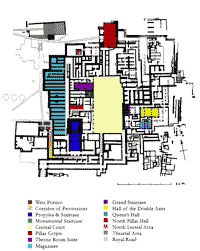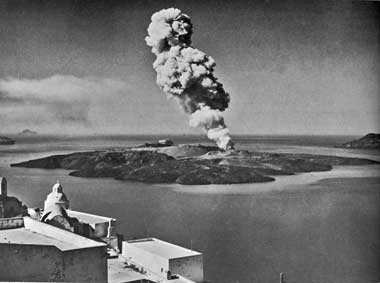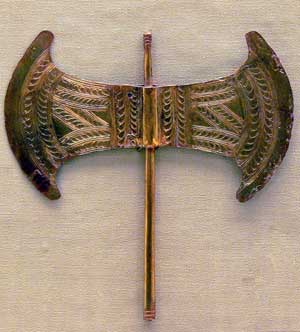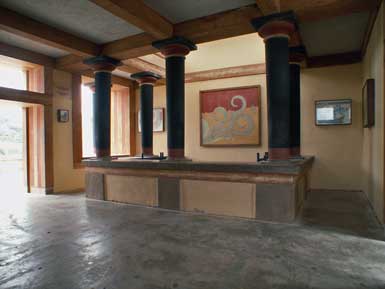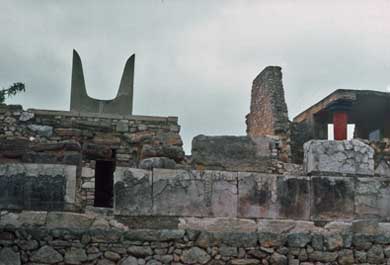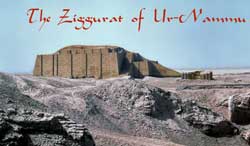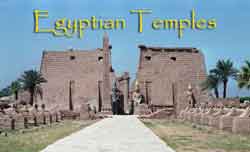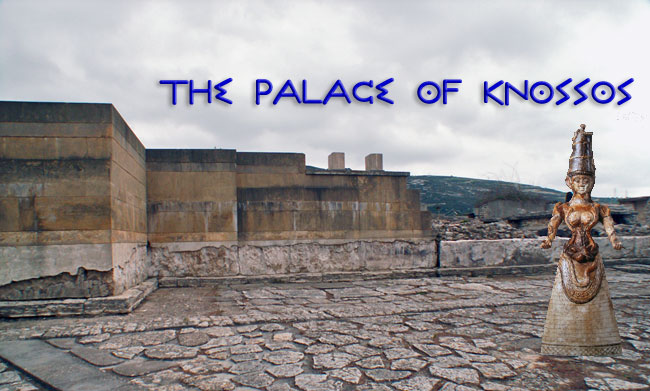
The Palace of Minos
Knossos
The complex at Knossos was built around 1900 BC, around the same time as the other major palaces at Phaistos, Kato Zakro and Mallia. The whole of the site, including all of the outlying buildings and tombs, covers an area of about 80 hectares (200 acres). Although there is evidence of occupation throughout, it is difficult to estimate its density but the size suggests an urban area with a population of several thousands. Obviously, the central and most important building was the palace but there were a number of smaller buildings containing ceremonial elements. Evans believed they were the homes of the local gentry and called them ‘villas’ or ‘mansions’ but given the religious nature of these elements perhaps it is better to think of them as shrines. More about them in a future article.
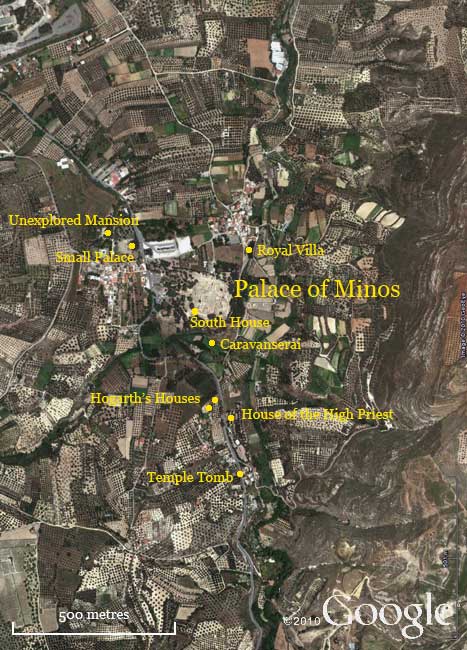
GoogleEarth View of Knossos & Vicinity
The Labyrinth
The Palace was in use for about 700 years, but there were two major interruptions. The first was a massive earthquake, which apparently destroyed all of the palaces in Crete some time around 1700 BC. It is almost certain that this was directly linked to the volcanic eruption that blew the island of Santorini apart at about the same time. Like the other palaces, Knossos was immediately rebuilt, bigger and better than before. The second was probably the result of the capture of the city by Mycenaean Greeks from the mainland in 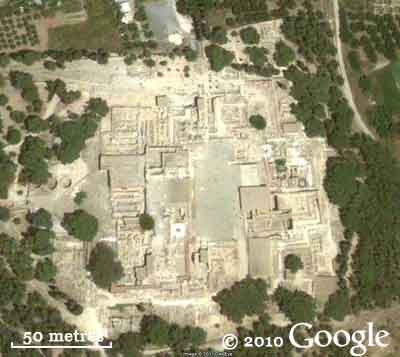 approximately 1450 BC. Texts found in association with this phase of occupation were written in Linear B, which most scholars are convinced was an early form of Greek. Although this palace survived relatively undamaged, all of the others were destroyed and abandoned. The usual explanation is that the newcomers used Knossos as their headquarters and destroyed all rival centres of power. Occupation continued until perhaps as late as 1200 BC when the site was again destroyed by fire. This time it was not rebuilt.
approximately 1450 BC. Texts found in association with this phase of occupation were written in Linear B, which most scholars are convinced was an early form of Greek. Although this palace survived relatively undamaged, all of the others were destroyed and abandoned. The usual explanation is that the newcomers used Knossos as their headquarters and destroyed all rival centres of power. Occupation continued until perhaps as late as 1200 BC when the site was again destroyed by fire. This time it was not rebuilt.
The ruins visible today belong primarily to the Second Palace Period—a somewhat larger version of the one destroyed by the earthquake of ca. 1700 BC. At first glance, the layout seems rather rambling and haphazard but in reality it was very carefully thought out. It covered an area of approximately 150 x 150 metres (2.25 hectares or a little over 5.6 acres). As was the case with contemporary palaces elsewhere in Crete, the focal point of the complex was a large, rectangular Central Court and, like most of the others (Zakro being the exception) there was an extensive open area along the west side of the palace known as the West Court.
The West Wing contained most of the cult rooms and formal areas—as well as most of the storage facilities for agricultural products. It is generally believed that the upper storey included a number of halls with large windows overlooking the West Court where the elite of the palace watched the ceremonies taking place below. The East Wing was 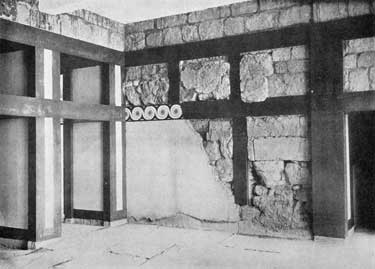 apparently far less formal. It included the industrial areas and workshops of the palace—and probably the domestic apartments as well.
apparently far less formal. It included the industrial areas and workshops of the palace—and probably the domestic apartments as well.
Stone was the primary building material (on the ground floor, at any rate) with a timber frame construction to provide flexibility in case of earthquake. The standard stone wall consisted of a mix of rubble and clay with facings of dressed masonry but solid masonry walls have also been found, Wood was used for the upper storeys and for all columns, roofs, door and window frames—these were reproduced in cement by Evans in the course of his restoration of the site (right). The interior walls were plastered with clay and, if they were to be painted, with a second coat of lime plaster. The floors of the more utilitarian rooms were generally of beaten earth but other materials include a type of cement mixed with small pebbles that Evans called tarazza as well as flagstone paving. Gypsum slabs were used for interior surfaces and limestone for areas such as courtyards that were exposed to the elements.
Lighting and ventilation in such a large complex presented a number of problems for the builders. Arranging 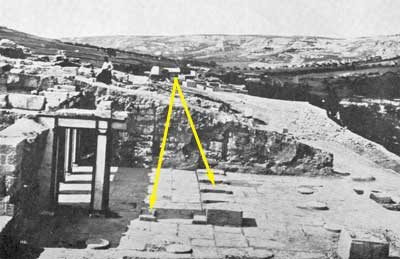 the rooms around large courtyards in the time honoured Near Eastern fashion reduced them somewhat but could never be the complete solution. While there is good evidence for windows in the upper storeys, ground floor windows raise issues of security and privacy and were probably used sparingly if at all. Some of the interior rooms could be lit by raising the height of the ceiling above that of the surrounding rooms and placing clerestory windows high on the walls. Obviously this method could not be used in every room and another solution was required. The answer was to use light-wells, vertical air shafts that ran the full height of the building. Some rooms could be opened up by means of a shuttered door system known as a polythyron. The photo (above left) shows the foundations of polythyrons in the Hall of the Double Axes.
the rooms around large courtyards in the time honoured Near Eastern fashion reduced them somewhat but could never be the complete solution. While there is good evidence for windows in the upper storeys, ground floor windows raise issues of security and privacy and were probably used sparingly if at all. Some of the interior rooms could be lit by raising the height of the ceiling above that of the surrounding rooms and placing clerestory windows high on the walls. Obviously this method could not be used in every room and another solution was required. The answer was to use light-wells, vertical air shafts that ran the full height of the building. Some rooms could be opened up by means of a shuttered door system known as a polythyron. The photo (above left) shows the foundations of polythyrons in the Hall of the Double Axes.
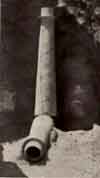 Drainage—a fundamental factor in the architecture of a building of this size—was looked after by an elaborate system of terracotta pipes and stone ductwork. The sections of pipe (right) were long and tapered, with collars to ensure a snug fit when joined together and sealed with clay. Many of the larger ones had one or more pairs of handles to aid in manoeuvring them. The engineering of the system was very precise with the gradients carefully measured. Not only were the builders able to deal with the sudden torrential downpours that occur periodically in the Cretan winter but were able to harness the flow to dispose of waste water from latrines and industrial areas of the palace. The best preserved section is beneath the domestic quarters in the East Wing and will be dealt with more fully in that part of the article.
Drainage—a fundamental factor in the architecture of a building of this size—was looked after by an elaborate system of terracotta pipes and stone ductwork. The sections of pipe (right) were long and tapered, with collars to ensure a snug fit when joined together and sealed with clay. Many of the larger ones had one or more pairs of handles to aid in manoeuvring them. The engineering of the system was very precise with the gradients carefully measured. Not only were the builders able to deal with the sudden torrential downpours that occur periodically in the Cretan winter but were able to harness the flow to dispose of waste water from latrines and industrial areas of the palace. The best preserved section is beneath the domestic quarters in the East Wing and will be dealt with more fully in that part of the article.
The network of pipes fed into larger, stone drains in each section of the complex. These were quite capacious and Evans was able to trace one that ran under the North Entrance Passage and North Pillar Hall, and into the neighbouring field.
Polythyrons
In the course of his excavations Evans uncovered a number of sets of multiple doors, which have come to be known as polythyrons or pier-and-door partitions. Essentially, these consist of a series of openings framed by square-sectioned wooden piers. Each wooden door is double-leafed and designed so that the two leaves fit into reveals on either side of the partition. They are not hinged but rather the whole door turns in sockets in the stone threshold and wooden lintel.
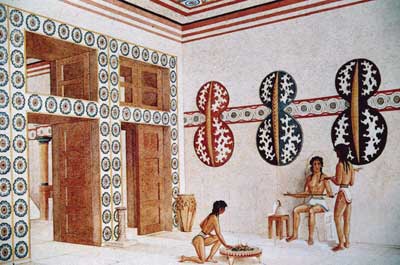
Reconstruction of the Polythyron doorways in the Hall of the Double Axes (Reconstruction in Watercolour by Piet de Jong)
The standard interpretation is that they were purely functional and used in much the same way as shuttered windows, to create privacy and to let in fresh air and light or to keep them out, as the case may be. There were quite a number of them in what Evans identified as the Domestic Quarters at Knossos. However, the number of doors seems excessive and the arrangement would have been most inefficient, especially in the winter. Certainly, the Hall of the Double Axes at Knossos (shown restored, above) has three ranges of polythyrons with no less than 11 doors, which seems a little extreme. More recently, it has been argued that they were associated with ritual activities that required, in the course of their proceedings, to be quickly darkened or lit.
Appearance
The palace at Knossos was built on a more human scale than the great palaces and temples of 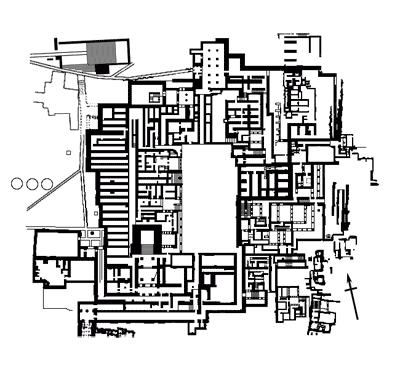 Mesopotamia and Egypt but it was still and awe-inspiring structure. It is true that the main focus seems to be inwards, on the Central Court that was the common feature of all Minoan palaces. The external façade was irregular, to say the least, especially on the eastern side (although it must be borne in mind that that side has been severely eroded).
Mesopotamia and Egypt but it was still and awe-inspiring structure. It is true that the main focus seems to be inwards, on the Central Court that was the common feature of all Minoan palaces. The external façade was irregular, to say the least, especially on the eastern side (although it must be borne in mind that that side has been severely eroded).
The formal approach was from the west and coming from that direction the visitor would have confronted a two storey building with large blocks of storage magazines on the ground floor, that presented a rather blank façade, supporting a second storey that mainly consisted of large, open halls with fair-sized windows facing the open courtyard below. The same sort of thing can be found at Phaistos and Mallia. At the north end was a block of broad steps, known as the Theatral Area, at the end of a long, straight paved roadway. The steps really don’t lead anywhere and so they probably served as a grandstand, where the elite within greeted the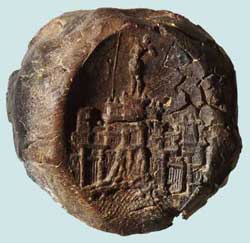 approach of processions of worshippers. At Phaistos there is a very similar arrangement.
approach of processions of worshippers. At Phaistos there is a very similar arrangement.
From Evans discoveries and representations of Minoan shrines and sanctuaries in their art, we know that the roof was crowned with so-called ‘Horns of Consecration,’ which undoubtedly represented the power of the bull with whose cult the Labyrinth is so closely linked. The device, like much else in Aegean Bronze Age civilization, was borrowed from Anatolia. The seal impression (left) was found at Chania and depicts a young, heroic figure (undoubtedly a god) standing on a mountain peak above a large, rambling building, its rooftops crowded with exactly such horns. From paintings we learn that the Minoans were particularly fond of deep, rich reds and blues in their decorative schemes. Walls and architectural elements such as columns or pillars were stuccoed and painted. Architraves (the beams supported by the columns) and other flat surfaces wer often decorated with chequerboard, running spiral or rosette patterns, carved in limestone.
Function
When Arthur Evans excavated the site at the beginning of the last century, he identified the building as a palace, a logical interpretation at the time. It was clearly a large complex and in the  Near East at the time there were only two sorts of large complexes—temples and palaces. Both were monumental in scale but temples tended to be much more formal in their layout with all of the major elements arranged along a single axis. Monumentality was the key (in the most important temples, at any rate), to reinforce the awesome power of the god. The epitome of this tendency was the ziggurat, a stepped platform with a temple at the top (such as the one, right, at Ur in southern Iraq). These often rose to heights of 50 metres or more, towering over the city below. Egyptian temples of the time were similarly monumental, with enormous pylons leading to a sequence of open courts and columned halls and finally to the sanctuary itself, at the heart of the complex.
Near East at the time there were only two sorts of large complexes—temples and palaces. Both were monumental in scale but temples tended to be much more formal in their layout with all of the major elements arranged along a single axis. Monumentality was the key (in the most important temples, at any rate), to reinforce the awesome power of the god. The epitome of this tendency was the ziggurat, a stepped platform with a temple at the top (such as the one, right, at Ur in southern Iraq). These often rose to heights of 50 metres or more, towering over the city below. Egyptian temples of the time were similarly monumental, with enormous pylons leading to a sequence of open courts and columned halls and finally to the sanctuary itself, at the heart of the complex.
The layout of the complex at Knossos was a much more random affair—at first glance, at any rate. There was no main axis and no real symmetry to the design. Much of the interior was given over to storage space and workshops. The other rooms are generally small and intimate. Evans identified small suites that he took to be domestic quarters. These were generally provided with light wells and polythyrons to ensure privacy yet also provide 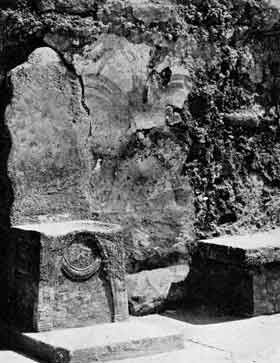 access to verandahs and small courts. The plumbing was excellent, with an elaborate system of latrines, drains and bathing facilities. Of course, the first thing he had discovered here was clearly a throne room—there was even a throne sitting against the wall! Apart from the size, there was nothing particularly monumental about it—no stepped tower; no grand entrance—nor was there anything that could be described as a cult image such as the colossal statues found elsewhere. There was art everywhere, but apparently no mythological scenes or depictions of cult activity. On the other hand, there were images of a regal looking young man (the ‘Prince of the Lilies’) along with scenes of athletic contests (bull-leaping), dancing, feasting and the world of nature. It all must have seemed much like the
access to verandahs and small courts. The plumbing was excellent, with an elaborate system of latrines, drains and bathing facilities. Of course, the first thing he had discovered here was clearly a throne room—there was even a throne sitting against the wall! Apart from the size, there was nothing particularly monumental about it—no stepped tower; no grand entrance—nor was there anything that could be described as a cult image such as the colossal statues found elsewhere. There was art everywhere, but apparently no mythological scenes or depictions of cult activity. On the other hand, there were images of a regal looking young man (the ‘Prince of the Lilies’) along with scenes of athletic contests (bull-leaping), dancing, feasting and the world of nature. It all must have seemed much like the 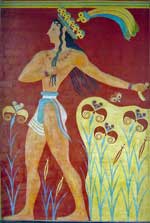 ideal life of a Victorian gentleman to Evans.
ideal life of a Victorian gentleman to Evans.
However, it is now clear that the throne room was a late addition, that the young man was not a king but a god, and that the games and other activities had a religious function. Moreover, there are no scenes of military triumphs nor processions of slaves and booty that typify the ideology of kingship in the ancient world. While it is true that there is no large sanctuary corresponding to the cella of a later Greek temple, there are a quite a number of smaller shrines within the complex including pillar crypts and lustral basins (discussed in more detail later). Even the throne room has been plausibly re-interpreted as a shrine. In fact, it is widely suspected that if anyone sat on that throne, it was probably a woman, either a priestess or a goddess. Women are commonly the focus of attention in the murals found at Knossos and men often reduced to the role of attendants. It is probably true that we have been using the wrong analogies when trying to interpret Knossos and the other ‘palaces’ of Crete, and that we should try to imagine something closer to a convent or monastery.
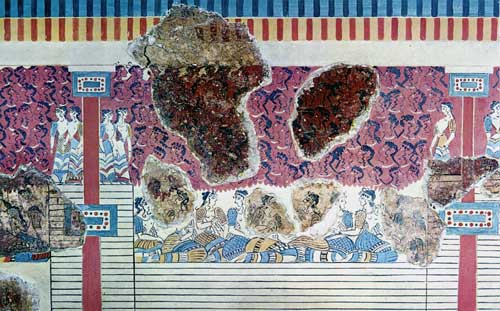
Detail of the Grandstand Fresco
Unless otherwise stated, all black & white photos of Knossos are from The Palace of Minos by Arthur Evans and are reproduced here courtesy of the Ashmolean Museum, Oxford University

